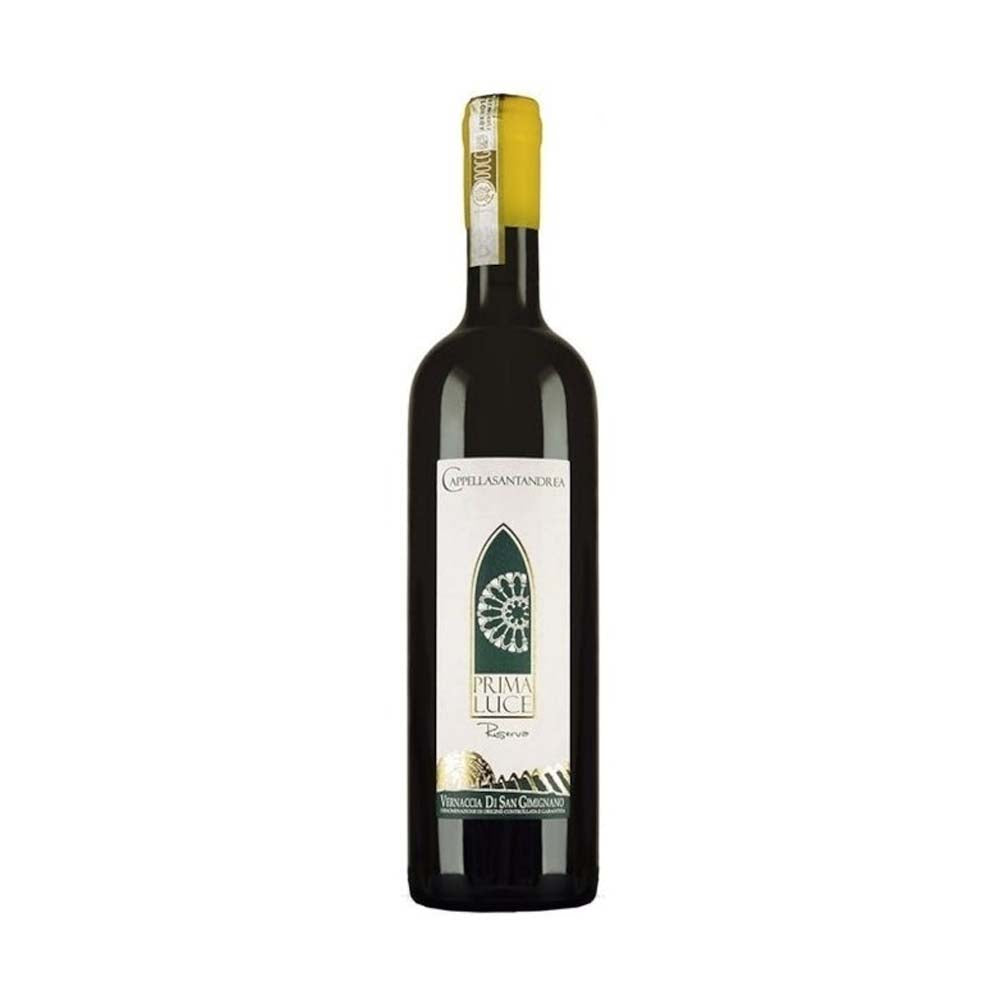
Prima Luce Vernaccia Reserve | Chapel of Sant'Andrea
DENOMINATION: Vernaccia di San Gimignano DOCG
TYPE: white
GRAPE VARIETY: vernaccia 100%
REGION OF ORIGIN: Italy, Tuscany
AGEING POTENTIAL: 2/3 years
SERVING TEMPERATURE: 10-12° C
GLASS: medium wide glass for white wine
ALCOHOL: 13% vol.
SIZE: 75 cl
THE WINE
TECHNICAL SPECIFICS
FRESHNESS: ◼︎◼︎◼︎◼︎◻︎
BODY: ◼︎◼︎◼︎◼︎◻︎
SAPIDITY: ◼︎◼︎◼︎◼︎◻︎
SOFTNESS: ◼︎◼︎◼︎◻︎◻︎
NOTES FROM OUR SOMMELIERS
👁 bright, deep straw yellow;
👃🏻 the nose expresses a citrus bouquet (lemon zest, mango), floral (white flowers, especially daisies), and a flash of crema catalana;
👄 on the palate it is drinkable and at the same time juicy and elegant, with a rather long finish;
FOOD PAIRING
This Vernaccia is immediately unclouded, with aromas that capture the interest, in which the flowers are the protagonists at first, without excess, and then make way for fruity notes.
It is endowed with sapidity, a robust structure, which allows it to accompany some varieties of red meat but usually finds the perfect match in white meat.
Try it with rabbit alla Vernaccia, hors d'oeuvres or delicate fish-based first courses, such as turbot.
REFINEMENT
With this label Sant'Andrea wanted to present a fresh and essential version of Vernaccia, a decidedly drinkable wine.
The Vernaccia grapes, harvested by hand in mid-September, are pressed whole, cold clarified briefly, and fermented in stainless steel at a regulated temperature; it is aged for about 6 months, and rests a further 2 months in the bottle before release.
YOU WILL LOVE IT FOR...
its freshness and very pleasant fruity notes.
ORIGIN
TERROIR
We are in San Gimignano, an area where wine-growing is king.
The territory of San Gimignano is an area characterised by a Mediterranean climate with rather dry summers, not particularly harsh winters and alternating rainfall, especially in April, May and November.
The area benefits from good ventilation throughout the year, with rare episodes of fog.
The production area of the protected designations falls entirely within the municipality of San Gimignano, in the north-west of the province of Siena, in the heart of Tuscany. It is an entirely hilly area situated between 200 and 400 m above sea level, with very ancient soil of Pliocene origin.
The soils destined for wine production are those formed on Pliocene marine deposits and consisting of yellow sands (tuff) and yellow clays that are, in turn, often stratified on more compact clays present at depth. In addition, these soils are strongly characterised by the presence of sand and are almost skeleton-free, incoherent and therefore favourable to the penetration of plant roots.
They are generally poor in organic matter and, thanks to the sand, are well drained. The tufa gives the wines flavour. The hills of San Gimignano have variable exposures, altitudes, soil compositions and water availability.
The many and unique combinations of these individual factors have a significant impact, even in such a small area, on the characteristics of the wines produced there, leading to substantial differences between the fruity characteristics in evidence, the mineral characteristics and the flavour.

WINERY
In the land of Brunello and Chianti, it is not easy for a Tuscan area to stand out for the production of a white wine, but this is what San Gimignano has done with great merit with its Vernaccia. The importance of the San Gimignano area's wine-growing history is demonstrated by one fact among many: Vernaccia di San Gimignano was the first wine to obtain D.O.C. status in 1966, together with Est! Est! Est! di Montefiascone, Ischia white, red and superior and Frascati.
The Cappella Sant'Andrea winery, in Casale di San Gimignano, condenses the industrious and proud spirit of an area with a very strong wine vocation, and manifests it in the passionate and conscious work of Flavia Del Seta and Francesco Galgani. Their first harvest was in 2006 and their approach was - and still is - first and foremost one of great respect for the vineyard and the land. Flavia and Francesco feel responsible for continuing a very old tradition.
At Cappella Sant'Andrea, the watchword is sustainability: conversion to organic farming is the logical consequence of their philosophy, but it is not the only step along the way. Cappella Sant'Andrea is in fact the meeting point of harmonious coexistence, where the vineyard shares the land with donkeys, goats and horses, under the universal sign of nature. The presence of the animals allows the self-production of compost, to be used for the vitality of the soil.
There are eight hectares of vines and in addition to Vernaccia, there are native Tuscan vines and Merlot.
The wines produced by Cappella Sant'Andrea are the summary in the bottle of the dimension that Flavia and Francesco have created, removed from the frenzy of modern society and directed towards a healthy and respectful production.

When will I receive my order?
If the bottle is in stock it will be sent immediately and you will receive it in a couple of working days.
Is the order renewed?
No, this product is not bound by any type of subscription and cannot be renewed.
Is there a minimum number of bottles?
No, you do not have to order a minimum quantity of bottles: you can choose to receive just one bottle of each type.

This product has no reviews yet.
